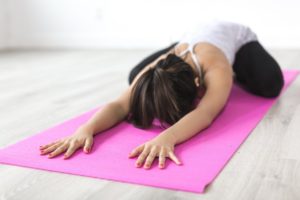By Stefanie Arend
Some types of yoga specify precisely how certain positions should look, and many people attempt to emulate this ideal image, whereas Yin Yoga is oriented towards the person practicing it. Our inner teacher is truly our most important yoga teacher, and I believe there is great healing potential when we listen to our bodies and trust ourselves as we practice, allowing the pose to develop as our bodies direct.
The style of Yin Yoga teaching in the Western world was founded in the late 1970s by martial arts expert and Taoist yoga teacher, Paulie Zink. Yin Yoga, as it is taught across North America and in Europe, was introduced by the Yin yoga teachers and developers, Paul Grilley and Sarah Powers. Grilley developed his own style of Yin Yoga by combining the stretching poses with the knowledge of the meridians and the importance of the individual anatomy. This is how he turned this style of yoga into a functional approach in comparison to yoga styles with many standardized alignment rules.
Yin Yoga is an intensive and at the same time very passive practice. The poses are carried out without any muscular tension, and the breathing should also be very gentle and effortless—we simply observe it. In Yin Yoga, you hold each position for around three to five minutes and your body remains as passive as possible. More advanced practitioners may hold each position for longer if they feel the impulse to do this. These passive stretches can have a positive effect on the deep layers of the body, and more particularly, on the fascia. They can help to loosen adhesions and shortening in the fascial structures in a gentle way and to make the tissue supple again. Yin Yoga can, therefore, reduce pain, encourage mobility, and—not least—harmonize the flow of energy in the meridians, as large parts of the meridians run the same course as the fascia chains in the body.
More and more studies show that many complaints can be alleviated, that the body can be strengthened, and that a healing journey can be supported through yoga. Yin Yoga has helped people with every possible symptom. As yoga can not only help the muscles, the fascia and nervous system, but can also have the effect of reducing stress, releasing anxiety, and becoming more mindful and relaxed.
The holistic practice of Yin Yoga is very versatile. For example, it can alleviate the side effects of chemotherapy or radiotherapy and enable cancer patients to get in touch with their body again. It can reduce the symptoms of multiple sclerosis, as well as fibromyalgia, asthma, and depression, and it can play an important part in the healing process for more everyday complaints such as backache, digestive problems or general internal turmoil.
Basically, Yin Yoga can help with any common ailment or illness because it helps to bring the chi back into balance. If there is too little chi in the body, the energy can be increased via the practice. If there is too much chi, it can be decreased. The body knows exactly what it has to do and balances out the energies as they are needed. When the energies are in harmony again, the body can activate its self-healing powers which are important for any healing processes. This is comparable to what happens during an acupuncture session.
Stefanie Arend is a renowned Yin Yoga instructor, holistic health coach, nutritionist and energy worker. As the first German author to focus exclusively on Yin Yoga, she is the author of six books, including the classic bestseller, Yin Yoga: The Gentle Path to the Inner Center (2011) and Surya Namaskar: The Sun Salutation (2014), both of which were named Best Yoga Book of the Year in German-speaking countries.
This is an excerpt from Be Healthy with Yin Yoga: The Gentle Way to Free Your Body of Everyday Ailments and Emotional Stresses.
 Conscious Community Magazine Dedicated to Elevating Consciousness
Conscious Community Magazine Dedicated to Elevating Consciousness





